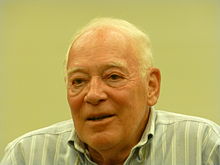Ellery Schempp
Ellery Schempp | |
|---|---|
 Ellery Schempp in 2012 | |
| Born | August 5, 1940 Philadelphia, PA |
Ellery Schempp (born Ellory Schempp, August 5, 1940) is a physicist[1] and is known for being the primary student involved in the landmark 1963 United States Supreme Court decision of Abington School District v. Schempp[2] which declared that required public school sanctioned Bible readings were unconstitutional.
Biography
Schempp was born in Philadelphia and grew up in the Roslyn community of Abington Township. He graduated from Abington High School in 1958, and attended Tufts University where he earned bachelor degrees in physics and geology.[1] In 1967, Schempp received his Ph.D. in physics from Brown University.[3]
In 1977, Schempp was part of the Pittsburgh Explorer’s Group Nanga Parbat Expedition which was to be the first American group to reach the peak of Nanga Parbat in Pakistan.
Schempp, who is retired, currently resides in Boston, Massachusetts.[4]
Stephen D. Solomon, a professor at New York University, has written a book about Schempp and the Supreme Court case entitled Ellery’s Protest: How One Young Man Defied Tradition and Sparked the Battle over School Prayer.[5]
Activism
On November 26, 1956, Schempp staged a protest against the school requirement that each student read 10 Bible passages and the Lord's Prayer each day during homeroom. That day he brought a copy of the Qur'an and read from it;[1] for this he was sent to the Principal's office. With the help of his father, Edward Schempp, and the American Civil Liberties Union, they sued the Abington School district over their policy of mandatory Bible readings.[3]
Over several years, Schempp, and later his younger siblings Roger and Donna, to continue standing in the case, continued to fight this policy in the courts. The Schempps were Unitarian Universalists, a theologically liberal religious community. The case was eventually decided in Schempps's favor by the Supreme Court in 1963, five years after he had graduated from high school.[2] The precedent that this decision established, that the public school does not have the right to sponsor religious exercises and then pressure students to take part in them has appeared time and time again in every church-state case focusing on religion in public schools.[6]
Schempp considers himself to be an atheist[3] but supports the Unitarian Universalist organizations and is a strong supporter of the ACLU and of the separation of church and state. He is a popular speaker at Unitarian Universalist and Secular Humanist meetings, where he speaks about his landmark protest as well as the current state of democracy, the constitution, and the bill of rights.
Schempp is a member of the American Humanist Association and Americans United for the Separation of Church and State. In 1996, he received the Religious Liberty Award from Americans United. He is on the Advisory Board of the Secular Student Alliance[7] and the Secular Coalition for America.[8] He has traveled throughout the country talking about his experiences.[9][10]
In 2002, Schempp was elected to Abington Senior High School's hall of fame for his accomplishments in physics. The award did include the notation “Initiated school prayer suit against Abington which was eventually decided by U.S. Supreme Court in 1963.”[1] His involvement in the court case was not mentioned in his acceptance speech except that he opened with the line, "I never thought they'd invite me back here."
Physics
Schempp's doctoral thesis was entitled Nuclear Quadrupole Resonance in Nitrogen Heterocycles. This work was the precursor to the development of magnetic resonance imaging (MRI) on which he continued to work for a substantial portion of his career.[1]
References
- ^ a b c d e Solomon, Stephen D. (Fall 2007). "The Kid Who Didn't Stand". Tufts University. Tufts Magazine. Retrieved 1 September 2013.
- ^ a b "ABINGTON SCHOOL DISTRICT v. SCHEMPP". Retrieved 1 September 2013.
- ^ a b c Bennett, Kitty (17 June 2011). "Ellery Schempp and the School Prayer Supreme Court Decision". AARP. Retrieved 1 September 2013.
- ^ Matza, Michael (7 August 2013). "Student's simple stand made history". The Inquirer. Retrieved 1 September 2013.
- ^ Solomon, Stephen (2009). "Ellery's Protest". Michigan Press. Retrieved 1 September 2013.
- ^ Boston, Rob (May 2013). "Ellery's Epic Exploit". American's United. Retrieved 1 September 2013.
- ^ "Advisory Board to the SSA". SSA website. Retrieved 1 September 2013.
- ^ "SCA Advisory Board Biography". Secular.org website. Retrieved 1 September 2013.
- ^ "A personal experience" (PDF). Low Country Humanists. November 2005. Retrieved 1 September 2013.
- ^ French, Kimberly (January–February 2003). "A victory for the heretics". uuworld.org. Retrieved 1 September 2013.
